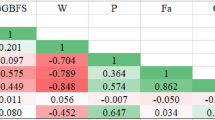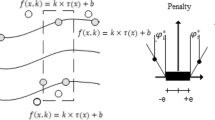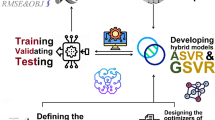Abstract
High-performance concrete (HPC) is extensively employed in the construction sector owing to its exceptional strength and durability. The mechanical characteristics of HPC, particularly its compressive and tensile strength, are vital indicators. Precise forecasts of concrete strength are essential for enhancing the design and performance of concrete structures. This study proposes a novel technique for predicting the strength of HPC. It involves utilizing the least square support vector regression (LSSVR) algorithm in combination with three optimizers: Gold Rush Optimizer, Political Optimizer, and Golden Sine Algorithm. LSSVR algorithm is a robust machine-learning method that has demonstrated favorable outcomes in numerous forecasting tasks. The use of LSSVR enables the accurate modeling and prediction of the intricate connection between the strongest attributes of HPC and the variables that impact it. To achieve this goal, a dataset containing 344 samples of high-performance concrete was gathered and utilized to train and assess the LSSVR algorithm. However, selecting appropriate optimization algorithms is critical for improving prediction accuracy and accelerating convergence speed. The proposed framework's performance is evaluated using actual strength data from HPC by conducting thorough experimentation and comparative analysis. The findings reveal that integrating LSSVR with the mentioned optimizers surpasses conventional optimization methods in prediction convergence speed and accuracy. The proposed framework offers a dependable and efficient solution for precisely predicting HPC strength, allowing engineers and researchers to optimize the design and construction of high-performance concrete structures.






Similar content being viewed by others
Data availability
The authors do not have permissions to share data.
References
Abdelhamid M, Kamel S, Mohamed MA, Aljohani M, Rahmann C, Mosaad MI (2020) Political optimization algorithm for optimal coordination of directional overcurrent relays. In: 2020 IEEE electric power and energy conference (Epec). IEEE, pp 1–7
Ahmad A, Chaiyasarn K, Farooq F, Ahmad W, Suparp S, Aslam F (2021) Compressive strength prediction via gene expression programming (GEP) and artificial neural network (ANN) for concrete containing RCA. Buildings 11(8):324
Akbarzadeh MR, Ghafourian H, Anvari A, Pourhanasa R, Nehdi ML (2023) Estimating compressive strength of concrete using neural electromagnetic field optimization. Materials 16(11):4200
Askari Q, Younas I, Saeed M (2020) Political optimizer: a novel socio-inspired meta-heuristic for global optimization. Knowl Based Syst 195:105709
Atici U (2010) Prediction of the strength of mineral-addition concrete using regression analysis. Mag Concr Res 62(8):585–592
Ayodele TO (2010) Types of machine learning algorithms. New Adv Mach Learn 3:19–48
Ayyadevara VK (2018) Pro machine learning algorithms. Apress, Berkeley
Bonaccorso G (2017) Machine learning algorithms. Packt Publishing Ltd, Birmingham
Botchkarev A (2018) Performance metrics (error measures) in machine learning regression, forecasting and prognostics: properties and typology. arXiv preprint arXiv:1809.03006
Cao S-G, Liu Y-B, Wang Y-P (2008) A forecasting and forewarning model for methane hazard in working face of coal mine based on LS-SVM. J China Univ Min Technol 18(2):172–176
Cheng M-Y, Chou J-S, Roy AFV, Wu Y-W (2012) High-performance concrete compressive strength prediction using time-weighted evolutionary fuzzy support vector machines inference model. Autom Constr 28:106–115
Cheng M-Y, Firdausi PM, Prayogo D (2014) High-performance concrete compressive strength prediction using Genetic Weighted Pyramid Operation Tree (GWPOT). Eng Appl Artif Intell 29:104–113
Chithra S, Kumar SRRS, Chinnaraju K, Ashmita FA (2016) A comparative study on the compressive strength prediction models for High Performance Concrete containing nano silica and copper slag using regression analysis and Artificial Neural Networks. Constr Build Mater 114:528–535
Chou J-S, Chiu C-K, Farfoura M, Al-Taharwa I (2011) Optimizing the prediction accuracy of concrete compressive strength based on a comparison of data-mining techniques. J Comput Civ Eng 25(3):242–253
Deepa C, SathiyaKumari K, Sudha VP (2010) Prediction of the compressive strength of high performance concrete mix using tree based modeling. Int J Comput Appl 6(5):18–24
Diab AAZ, Tolba MA, El-Magd AGA, Zaky MM, El-Rifaie AM (2020) Fuel cell parameters estimation via marine predators and political optimizers. IEEE Access 8:166998–167018
Erdal HI (2013) Two-level and hybrid ensembles of decision trees for high performance concrete compressive strength prediction. Eng Appl Artif Intell 26(7):1689–1697
Fletcher R (1987) Practical methods ofoptimization. Wiley, New York
Ghiasi MM, Shahdi A, Barati P, Arabloo M (2014) Robust modeling approach for estimation of compressibility factor in retrograde gas condensate systems. Ind Eng Chem Res 53(32):12872–12887
Haile BF, Jin DW, Yang B, Park S, Lee H-K (2019) Multi-level homogenization for the prediction of the mechanical properties of ultra-high-performance concrete. Constr Build Mater 229:116797
Hameed MM, AlOmar MK (2020) Prediction of compressive strength of high-performance concrete: hybrid artificial intelligence technique. In: Applied computing to support industry: innovation and technology: first international conference, ACRIT 2019, Ramadi, Iraq, September 15–16, 2019, Revised Selected Papers 1. Springer, pp 323–335
Han Q, Gui C, Xu J, Lacidogna G (2019) A generalized method to predict the compressive strength of high-performance concrete by improved random forest algorithm. Constr Build Mater 226:734–742
Khosravani MR, Nasiri S, Anders D, Weinberg K (2019) Prediction of dynamic properties of ultra-high performance concrete by an artificial intelligence approach. Adv Eng Softw 127:51–58
Kisi O (2015) Streamflow forecasting and estimation using least square support vector regression and adaptive neuro-fuzzy embedded fuzzy c-means clustering. Water Resour Manage 29:5109–5127
Kisi O, Parmar KS (2016) Application of least square support vector machine and multivariate adaptive regression spline models in long term prediction of river water pollution. J Hydrol (amst) 534:104–112
Kumar M, Kar IN (2009) Non-linear HVAC computations using least square support vector machines. Energy Convers Manag 50(6):1411–1418
Lai KK, Yu L, Zhou L, Wang S (2006) Credit risk evaluation with least square support vector machine. In: Rough sets and knowledge technology: first international conference, RSKT 2006, Chongquing, China, July 24–26, 2006. Proceedings 1. Springer, pp 490–495
Li Q-F, Song Z-M (2022) High-performance concrete strength prediction based on ensemble learning. Constr Build Mater 324:126694
Li Y, Wen PP (2011) Clustering technique-based least square support vector machine for EEG signal classification. Comput Methods Programs Biomed 104(3):358–372
Liu Y (2022) High-performance concrete strength prediction based on machine learning. Comput Intell Neurosci 2022:1
Liu Q, Li N, Jia H, Qi Q, Abualigah L, Liu Y (2022) A hybrid arithmetic optimization and golden sine algorithm for solving industrial engineering design problems. Mathematics 10(9):1567
Mahesh B (2020) Machine learning algorithms—a review. Int J Sci Res (IJSR) [internet] 9:381–386
Mahmoodi NM, Arabloo M, Abdi J (2014) Laccase immobilized manganese ferrite nanoparticle: synthesis and LSSVM intelligent modeling of decolorization. Water Res 67:216–226
Masoumi F, Najjar-Ghabel S, Safarzadeh A, Sadaghat B (2020) Automatic calibration of the groundwater simulation model with high parameter dimensionality using sequential uncertainty fitting approach. Water Supply 20(8):3487–3501
Moreno-Salinas D, Chaos D, Besada-Portas E, López-Orozco JA, de la Cruz JM, Aranda J (2013) Semiphysical modelling of the nonlinear dynamics of a surface craft with LS-SVM. Math Probl Eng 2013:1
Naseri H, Jahanbakhsh H, Hosseini P, MoghadasNejad F (2020) Designing sustainable concrete mixture by developing a new machine learning technique. J Clean Prod 258:120578
Naseri H, Jahanbakhsh H, Khezri K, Shirzadi Javid AA (2022) Toward sustainability in optimizing the fly ash concrete mixture ingredients by introducing a new prediction algorithm. Environ Dev Sustain 24(2):2767–2803
Sarjamei S, Massoudi MS, Esfandi Sarafraz M (2021) Gold rush optimization algorithm. Iran Univ Sci Technol 11:291–327
Sarjamei S, Massoudi MS, Sarafraz ME (2022) Damage detection of truss structures via gold rush optimization algorithm. Int J Optim Civil Eng 12(1):69–89
Sedaghat B, Tejani GG, Kumar S (2023) Predict the maximum dry density of soil based on individual and hybrid methods of machine learning. Adv Eng Intell Syst 002(03)
ShirzadiJavid AA, Naseri H, EtebariGhasbeh MA (2021) Estimating the optimal mixture design of concrete pavements using a numerical method and meta-heuristic algorithms. Iran J Sci Technol Trans Civ Eng 45(2):913–927
Suykens JAK, Vandewalle J (2000) Kisi, O. Streamflow forecasting and estimation using least square support vector r. IEEE Trans Circ Syst i Fundam Theory Appl 47(7):1109–1114
Tanyildizi E (2018) A novel optimization method for solving constrained and unconstrained problems: modified golden sine algorithm. Turk J Electr Eng Comput Sci 26(6):3287–3304
Tanyildizi E, Demir G (2017) Golden sine algorithm: a novel math-inspired algorithm. Adv Electr Comput Eng 17(2):71–78
Wu X, Zheng S, Feng Z, Chen B, Qin Y, Xu W, Liu Y (2022) Prediction of the frost resistance of high-performance concrete based on RF-REF: a hybrid prediction approach. Constr Build Mater 333:127132
Zain MFM, Abd SM (2009) Multiple regression model for compressive strength prediction of high performance concrete. J Appl Sci 9(1):155–160
Zain MFM, Mahmud HB, Ilham A, Faizal M (2002) Prediction of splitting tensile strength of high-performance concrete. Cem Concr Res 32(8):1251–1258
Zhang F, O’Donnell LJ (2020) Support vector regression. Machine learning. Elsevier, Oxford, pp 123–140
Zhang J, Wang J-S (2020) Improved whale optimization algorithm based on nonlinear adaptive weight and golden sine operator. IEEE Access 8:77013–77048
Author information
Authors and Affiliations
Contributions
CL: Writing—Original draft preparation, Conceptualization, Supervision, Project administration.
Corresponding author
Ethics declarations
Conflict of interest
The authors declare no competing of interests.
Additional information
Publisher's Note
Springer Nature remains neutral with regard to jurisdictional claims in published maps and institutional affiliations.
Rights and permissions
Springer Nature or its licensor (e.g. a society or other partner) holds exclusive rights to this article under a publishing agreement with the author(s) or other rightsholder(s); author self-archiving of the accepted manuscript version of this article is solely governed by the terms of such publishing agreement and applicable law.
About this article
Cite this article
Lu, C. Compressive strength prediction of high-performance concrete with utilization of automated least square support vector regression-based algorithm. Multiscale and Multidiscip. Model. Exp. and Des. (2023). https://doi.org/10.1007/s41939-023-00312-3
Received:
Accepted:
Published:
DOI: https://doi.org/10.1007/s41939-023-00312-3




